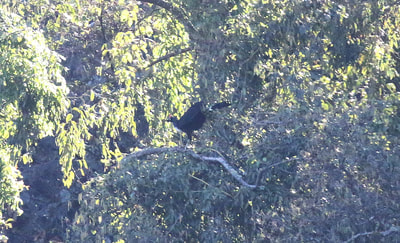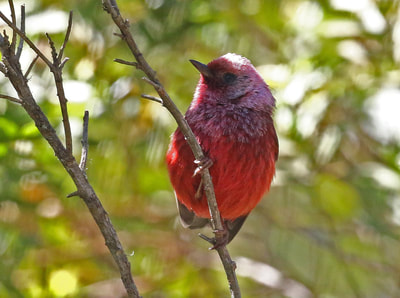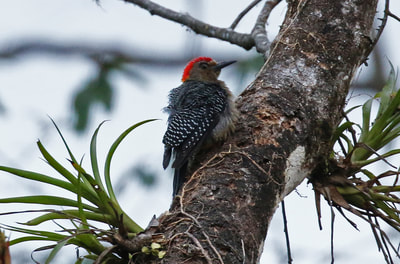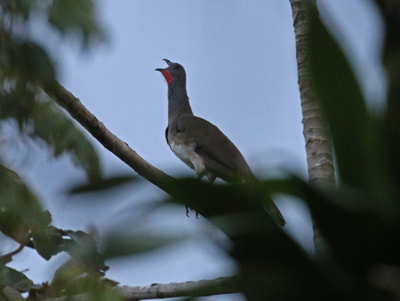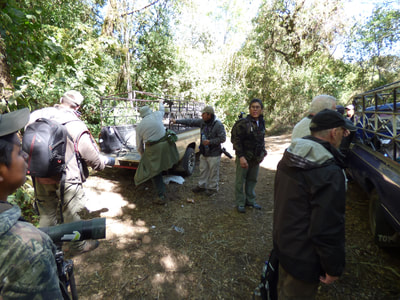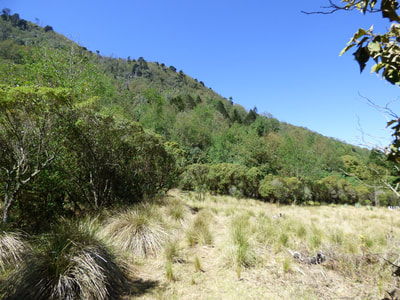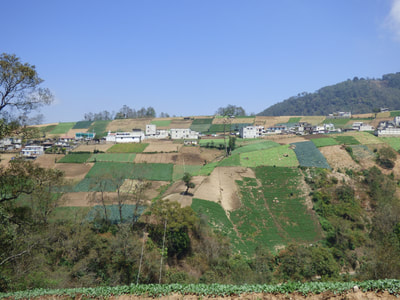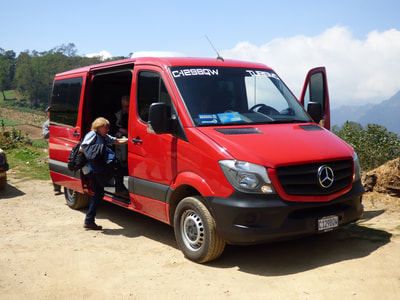28th February
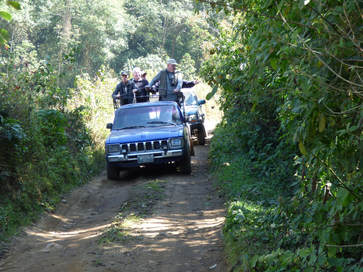 Returning after the success
Returning after the success
Up before the larks this morning, for coffee and biscuits at 4:45 a.m. !! We then departed at 5 a.m., drove a short way, then divided into two groups travelling standing up in the back of two adapted FWD pick-up trucks. It was very cold, as we went up to an altitude of 10,000 ft driving for 3/4 to 1 hour into the cloud forest, which was basically in a different location in the Fuentes Georginas area. This was a new area which had been recce'd previously and was intended to obviate the need for the previous need for a 3-4 hr steep hike at another known location near Lake Atitlan. On this excursion we were accompanied by a couple of other guides including Benedicto, the chief photographer of Birding Expeditions, who had done some recce's of this area. On the way up in the truck we heard Mexican Whip-poor-wills calling and the lead truck had one fly in front of it. As dawn was breaking the driveable track came to an end and we then proceeded slowly uphill on foot [one could feel the affects of altitude] to an area where the birds were known to be. We of course birded as we went along and met some new species, among which were Black-throated Jay, which I think was even a lifer for Fernando, plus Spot-crowned Woodcreeper, Swainson's Thrush, Swainson's Hawk and Yellowish Flycatcher. Eventually we reached the right spot which looked across a fairly deep forested valley. Viewing wasn't easy as we were in amongst the vegetation and standing on a slope, so getting a firm standing position for the 'scopes wasn't easy. We scanned and scanned the 100's of trees on the opposite side of the valley for ages with no luck. Apparently the Guans favourite food is from the so-called Devil's Finger Tree and there was a patch of this across the valley. This habitat is apparently very fragmented which is why the bird is so rare. {I freely admit to pinching this info from Fernando's official trip report}. We had more or less given up and started to make our way down the track when a shout went up - Benedicto had found a bird! Up we went again and now it was a case of gently does it as we tried to get everyone to get at least a brief view of the primeval-looking Horned Guan, with its strange red vertical horn sticking up from the base of its bill. There was only time to set up one 'scope so speedy viewing was required. Sadly Dave was the only one who didn't get sight of it before it dropped down into the dense foliage, plus Lesley who had decided the trek uphill was too much [it was pretty tough]. It was so far away across the valley and the sun was coming round to face us so getting a shot was pretty difficult. I took quite a few and have managed to salvage a half recognisable record shot.
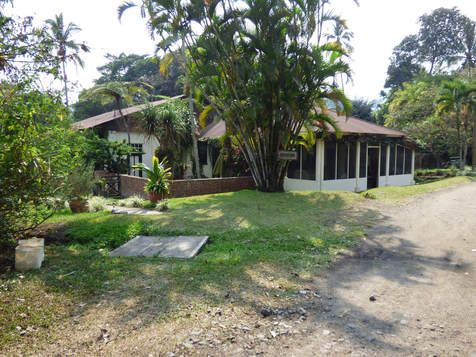 Los Tarrales main building & dining room
Los Tarrales main building & dining room
Now flush with success we moved down the hill and after a while we stopped at a clearing that looked promising. Within a couple of minutes we were watching a very confiding Pink-headed Warbler feeding in the low bushes, and soon cameras were clicking away for that crippler of a shot. We had a few other good birds in addition to this including some new warblers in the shape of Audubon's, Crescent-chested, and Golden-browed, plus Red-tailed Hawk and Turkey & Black Vultures, the latter two being everyday birds, and a few other species which by now were becoming familiar. We now made our way back down to Zunil and back to Las Cumbres where we packed and had lunch.
We then set off to travel to our next destination of Los Tarrales Natural Reserve, which is near the town of Patulul to the south of Lake Atitlan. This is another private reserve where the primary forest is preserved, but where local people live and work, growing coffee and, as we found out as we walked around, what we call house plants such as mother-in-laws-tongue {Sansevieria trifasciata}. The drive took around 3 hours and we stopped en route. Species noted during the journey included Western Cattle Egret, Snowy Egret, American Kestrel, and at a fuel stop, 4 spectacular White-throated Magpie-jays. We arrived at Los Tarrales and were allocated our rooms which were in small groups with a common lounge area for each group. We then had about an hour for a short walk before nightfall. We picked up a few new birds amongst now familiar ones, including Orange-chinned Parakeet and Yellow-naped Amazon, plus Spot-breasted Oriole, Melodious Blackbird, Yellow-throated Euphonia, Tropical Pewee, Crested and Highland Guans, noisy White-bellied Chachalacas, and Cinnamon Hummingbird. Also, just as dusk was falling and the light going, I spotted a couple of Lesser Nighthawks flying around over the buildings.
We then set off to travel to our next destination of Los Tarrales Natural Reserve, which is near the town of Patulul to the south of Lake Atitlan. This is another private reserve where the primary forest is preserved, but where local people live and work, growing coffee and, as we found out as we walked around, what we call house plants such as mother-in-laws-tongue {Sansevieria trifasciata}. The drive took around 3 hours and we stopped en route. Species noted during the journey included Western Cattle Egret, Snowy Egret, American Kestrel, and at a fuel stop, 4 spectacular White-throated Magpie-jays. We arrived at Los Tarrales and were allocated our rooms which were in small groups with a common lounge area for each group. We then had about an hour for a short walk before nightfall. We picked up a few new birds amongst now familiar ones, including Orange-chinned Parakeet and Yellow-naped Amazon, plus Spot-breasted Oriole, Melodious Blackbird, Yellow-throated Euphonia, Tropical Pewee, Crested and Highland Guans, noisy White-bellied Chachalacas, and Cinnamon Hummingbird. Also, just as dusk was falling and the light going, I spotted a couple of Lesser Nighthawks flying around over the buildings.
